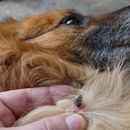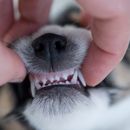Application and areas of use of clomipramine
Clomipramine is a widely used medication for the treatment of various behavioral disorders in dogs that acts on the central nervous system. It is considered an antidepressant that primarily blocks the reuptake of serotonin and is often used to support behavioral therapies for separation-related behavioral problems in dogs. Another special feature is that it is also suitable for geriatric animals, i.e. older dogs, that are struggling with behavioral changes.
Anxiety and separation anxiety
Dogs suffering from separation anxiety can be treated well with clomipramine. This anxiety disorder, in which dogs become extremely stressed when left alone, often leads to unwanted behavior such as destroying objects, excessive barking or urinating in the house. The combination of clomipramine and behavioral therapy or lifestyle changes can help alleviate these problems.
Long-term anxiety and panic reactions, such as to thunderstorms, can also be treated with clomipramine. In some cases, it is administered together with alprazolam, a tranquilizer, which increases the effect and helps the dog to calm down more quickly.
Aggressive behavior
Clomipramine is successfully used to treat aggression problems, especially when these are triggered by dominance or fear. In dogs that react aggressively due to insecurity or dominance behaviour, the medication can help to stabilize the behaviour. As always, however, the reason for the aggressive behavior should first be identified before starting therapy with medication.
Obsessive-compulsive disorders and stereotypies
Dogs suffering from obsessive-compulsive disorders (stereotypies), such as excessive licking, tail chasing or nail biting, can be treated with clomipramine. These behaviors are often difficult to break, but the drug can help reduce the compulsion and make the dog feel more comfortable.
Psychogenic dermatoses
Clomipramine has also been shown to be effective for psychogenic dermatoses, which are characterized by self-injury, lick dermatitis or itching. These skin problems often have a psychological cause, and treatment with clomipramine can alleviate the symptoms.
Narcolepsy
Another area of application for clomipramine is the treatment of narcolepsy, a rare sleep disorder in which dogs suddenly fall asleep. Here, the medication helps to alleviate the symptoms.

Properties of clomipramine
Clomipramine is a tricyclic antidepressant (TCA) and works primarily by inhibiting the reuptake of serotonin and noradrenaline. These two neurotransmitters play a crucial role in the central nervous system and influence behavior.
How does clomipramine work?
Clomipramine inhibits the reuptake of serotonin and, in higher doses, also of noradrenaline from the synaptic cleft into the nerve cells. This increases the concentration of these neurotransmitters, which prolongs their duration of action and leads to a long-term improvement in behavior. It is interesting (and important to note!) that the antidepressant effect only occurs after a few days to weeks, although the neurotransmitter concentration increases rapidly. This is due to a series of adaptive processes in the brain that, over time, cause receptors to change and mood or behavior to stabilize.
Why is clomipramine so effective for behavioral disorders?
In dogs and other animals that suffer from behavioral problems, such as aggression, anxiety or obsessive-compulsive disorder, the cause is often an impairment of the neurotransmitters serotonin, noradrenaline or dopamine. Clomipramine intervenes in this metabolism and thus improves communication between the nerve cells, which can normalize behaviour. Serotonin deficiency in particular is closely associated with aggression, which is why clomipramine often shows good results with these problems.
Use of clomipramine
If your dog has already been prescribed clomipramine, the vet will usually have already given you all the important information about dosage and administration . If you think clomipramine could help your dog, but it has not yet been discussed with a behavioral medicine specialist, this is absolutely necessary beforehand. The recommended dosage is usually 2-4 mg/kg per day, divided into two doses.
Side effects and effects
Studies report positive effects, especially when behavioral therapy and clomipramine are combined. However, the benefits of clomipramine alone have not yet been clearly proven.
Clomipramine also blocks other receptors in the nervous system, which can lead to undesirable effects. These include, for example, dry mucous membranes, changes in appetite or heart problems. A possible dependency must also be taken into account, which is why the dose should be reduced slowly at the end of treatment.
Interactions with other medications
Clomipramine should not be combined with MAO inhibitors, and if switching to another substance group, a gap of several weeks is necessary. Due to its high binding to plasma proteins, clomipramine can displace other drugs and increase their effect, especially with antiarrhythmics, anticholinergics, sympathomimetics, coumarin derivatives and central depressants. This is another reason why it is essential to be in contact with a veterinarian during therapy.
Summary and conclusion on clomipramine in dogs
Clomipramine is an effective antidepressant that stabilizes behavior in dogs and cats with behavioral disorders by increasing serotonin and norepinephrine levels in the brain. Although it can have several side effects, it is particularly helpful for aggression, obsessive-compulsive disorder and anxiety. However, treatment should always be administered under veterinary supervision, as special care should be taken in animals with heart problems or sensitive reactions.
Sources and relevant links
CliniPharm/CliniTox
Accessed on 15.10.2024
Barbara Schneider, Daphne Ketter (2016). Verhaltensmedizin bei Hund und Katze. Schattauer.
Löscher W, Richter A (2016). Lehrbuch der Pharmakologie und Toxikologie für die Veterinärmedizin. 4., vollständig überarbeitete Auflage. Enke Verlag.
Clomicalm
Accessed on 09.11.2024

















